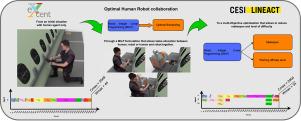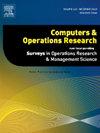人机协作的多目标优化:航空航天装配线案例研究
IF 4.1
2区 工程技术
Q2 COMPUTER SCIENCE, INTERDISCIPLINARY APPLICATIONS
引用次数: 0
摘要
协作机器人技术在工业 5.0 领域日益盛行,因此,改善人类与机器人之间的互动与协作的需求也与日俱增。然而,目前定义人与机器人责任分担的方法是经验性的,将机器人作为零件的主动夹具,这是建立高效协作的次优方法。本文基于一个真实世界的使用案例,重点探讨如何优化航空航天工业装配线上的人机协作。本研究采用的方法是利用多目标优化(MOO)方法,有效解决缩短工期和降低工作难度的问题。在实施过程中对两种技术进行了比较:加权求和法和ɛ-约束法,这两种方法可以同时生成解决多个目标的解决方案。研究结果为机器人技术主管提供了一种新工具,用于设计人与机器人之间的协作模式,对实际工业应用具有实际意义。该解决方案可产生多项成果,包括提高公司竞争力和生产率,同时保持人类在公司中的核心作用并改善其福利。本文章由计算机程序翻译,如有差异,请以英文原文为准。

Multi objective optimization of human–robot collaboration: A case study in aerospace assembly line
Collaborative robotics is becoming increasingly prevalent in industry 5.0, leading to a growing need to improve interactions and collaborations between humans and robots. However, the current approach to defining the sharing of responsibilities between humans and robots is empirical and uses the robot as an active fixture of parts, which is a sub-optimal method for establishing efficient collaboration. This article focuses on optimizing human–robot collaboration on an assembly line within the aerospace industry based on a real-world use case. The methodology adopted in this research entails employing the multi-objective optimization (MOO) method to effectively tackle both the reduction of makespan and the mitigation of working difficulty. Two techniques have been compared for implementation: the weighted sum and the -constraint methods, which allow the generation of solutions addressing multiple objectives simultaneously. The results offer chief robotics officers a new tool to design collaboration patterns between humans and robots, with practical implications for real industrial applications. This solution produces several results, including improving company competitiveness and productivity, while maintaining the central role of humans within the company and improving its well-being.
求助全文
通过发布文献求助,成功后即可免费获取论文全文。
去求助
来源期刊

Computers & Operations Research
工程技术-工程:工业
CiteScore
8.60
自引率
8.70%
发文量
292
审稿时长
8.5 months
期刊介绍:
Operations research and computers meet in a large number of scientific fields, many of which are of vital current concern to our troubled society. These include, among others, ecology, transportation, safety, reliability, urban planning, economics, inventory control, investment strategy and logistics (including reverse logistics). Computers & Operations Research provides an international forum for the application of computers and operations research techniques to problems in these and related fields.
 求助内容:
求助内容: 应助结果提醒方式:
应助结果提醒方式:


